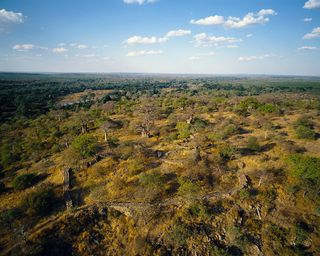Thulamela: Iron-Age Kingdom in South Africa

The city of Thulamela flourished in South Africa between the 13th and 17th centuries. Its inhabitants imported goods from as far away as China.
Covering nine hectares (22 acres) and located on the northern tip of Kruger National Park in northeastern South Africa, the site was excavated during the 1990s and contains a series of stone enclosures built on a hill.
"What we can say from the archaeological evidence uncovered at the site is that a stratified community lived at Thulamela; elites probably on the top of the hill while the rest of the populace occupied the adjacent areas below. It is commonly said that about 1,000 people lived above and 2,000 below, although this is speculative since no systematic survey or remote sensing has been conducted," wrote Lynn Meskell, an anthropology professor at Stanford University, in a paper published in 2007 in the Journal of Southern African Studies.
Archaeologists are unsure what the people who lived in the city called it. Meskell wrote that the name "Thulamela" is a modern-day name that can mean "place of birth" or alternatively may refer to hunted meat in the language of the Venda people.
The site was in use between the 13th and 17th centuries A.D., wrote a team of archaeologists led by Maryna Steyn in a paper published in 1998 in the South African Archaeological Bulletin. The archaeologists reported finding the graves of a man and woman who were buried with a variety of gold jewelry, including hundreds of gold beads as well as gold necklaces and bangles.
Analysis of the woman's bones revealed that she was about 5.7 feet (1.7 meters) tall, robustly built and was 45 to 60 years old when she died. The man's skeleton was in poor condition and his height, build and age of death are uncertain. The large amount of gold jewelry found in the graves led archaeologists to think that both individuals held an elite rank.
The modern-day communities that live by Kruger National Park requested that both individuals be treated with respect. "At the request of local communities, the remains of both individuals were ceremoniously reburied in their original graves during the first half of 1997," the archaeological team wrote in their 1998 paper.
Trade
When Thulamela was excavated in the 1990s, archaeologists found the remains of Chinese porcelain and glass beads, along with other trade goods. These discoveries show that Thulamela was part of a trade network "where the export of iron, copper, gold and tin from southern Africa via the Indian Ocean trade network was exchanged for glass beads and other luxury goods, thus demonstrating economic contact with North Africa, the Middle East, India and China," wrote Meskell in her 2007 paper.
Study of the faunal remains show that the people who lived at Thulamela had regular contact with people who lived on the east coast of Africa. "The large variety of marine mollusk species found at Thulamela may indicate more regular east coast contact," wrote Ina Plug, a researcher at the Transvaal Museum, in a paper published in 2000 in the South African Archaeological Society Goodwin Series (a volume of archaeological research papers).
Metal production
In addition to gold jewelry, the people who lived at Thulamela manufactured artifacts made of copper, iron and bronze. One remarkable artifact is a double iron gong that was found near the graves of the man and woman. Archaeologists say that the gong may have been a symbol of royalty.
When the gold work was analyzed researchers found that it had the same "chemical fingerprint" as gold artifacts found at another site called Mapungubwe, which flourished between roughly A.D. 1075 to 1220, a time before Thulamela existed. "The conclusion could therefore be drawn that both the Mapungubwe (gold artifacts) and Thulamela (gold) artifacts originated from the same gold source," wrote a team of researchers in a paper published in 1998 in the journal Gold Bulletin.
Researchers have also noted similarities between the artifacts manufactured at Thulamela and those from another site called Great Zimbabwe, which flourished between roughly A.D. 1100 and 1450.
Decline and abandonment
Archaeological research indicates that Thulamela was abandoned during the 17th century. "At the end of the sixteenth century the people of Thulamela still prospered but from then on the slow drying out of the region, the influence of the Portuguese and civil war in Zimbabwe probably made life untenable. The site was abandoned early in the seventeenth century," wrote Steyn's team in the 1998 paper.
It wasn't until 1983 that Thulamela was rediscovered by a park ranger, and it wasn't until the 1990s, after the collapse of the apartheid system in South Africa, that the site was excavated on a large scale and restored.
Additional resources
Sign up for the Live Science daily newsletter now
Get the world’s most fascinating discoveries delivered straight to your inbox.

Owen Jarus is a regular contributor to Live Science who writes about archaeology and humans' past. He has also written for The Independent (UK), The Canadian Press (CP) and The Associated Press (AP), among others. Owen has a bachelor of arts degree from the University of Toronto and a journalism degree from Ryerson University.
